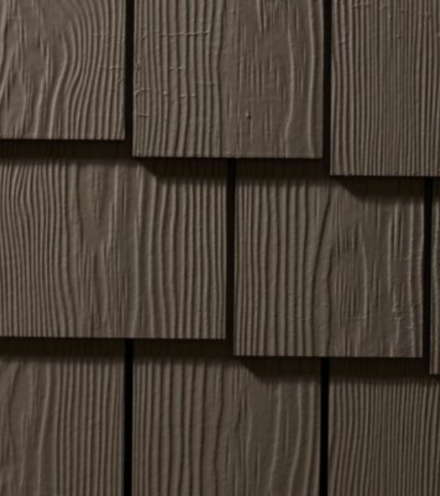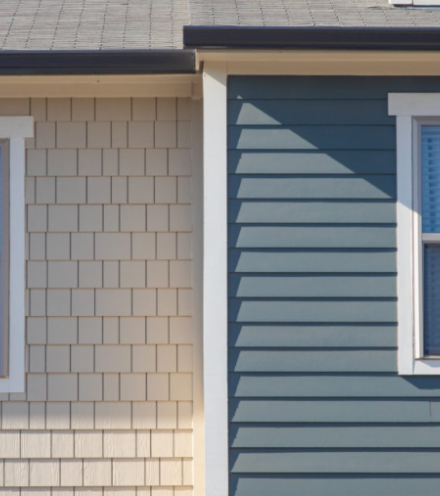“How do I measure my house for siding?” It’s a common question that ambitious DIY homeowners ask before setting off on an exterior remodel. Measuring for siding can be tricky, especially if you’re working with a home that has unique architectural features, like triangular dormers or arched windows.
This article is a helpful guide to avoid common mistakes as you learn how to measure for siding like a pro. With some advanced planning and sound advice, you’ll know how to measure for siding in no time – and how to find the best siding styles on the market!
3 Signs You Need New Siding
There are lots of reasons why folks need to know how to measure a house for siding. Do any – or all – of these reasons for new siding sound familiar?

Old, Faded, or Ugly Siding
Exterior damage and deterioration can compromise the curb appeal of your home and lead to more problems down the line, like moisture damage. Traditional siding materials like wood and vinyl are notorious for accruing noticeable damage in a relatively short amount of time.
If you’re learning how to measure siding for house damage touch-ups, you may want to consider upgrading the entire home’s exterior with a more durable, longer lasting siding material.
Poor Energy Efficiency
High heating and cooling bills can be a sign that air is leaking out through the siding and causing you to spend more. Modern siding is designed to be energy efficient, and to lower your carbon footprint – and your energy bills!
Revitalize the Home
You may simply want to give your home a face lift. New siding is the easiest way to make a noticeable difference in your home’s curb appeal and get an instant refresh.
How to Measure for Home Siding
No matter what your reason, installing new siding can be an exciting project – that is, if you can avoid the logistics headaches. Taking proper measurements is an important task, because it can influence how much siding you purchase.
You definitely don’t want to be caught coming up short as the project wraps up. On the other hand, there’s no need to buy more siding than you need, as this can create excess material waste that is bad for the environment – and your wallet.
Here is a basic step-by-step guide on how to measure siding for a house:
1. Calculate the total square footage.
Many suppliers sell siding by square footage, so calculating the surface area is key. To calculate the square footage of a flat exterior wall, multiply the height times the width.
2. Measure additional pop-out areas and add this figure to the total square footage.
These are other spots like gables and dormers that will require siding. For triangular shapes, multiply the height (base of triangle to top peak) by half of the base length.
3. Subtract the total square footage of uncovered areas.
These are areas that are not covered by siding, like windows and doors.
Some houses have tons of uniquely shaped windows and decorative features that make measuring for siding difficult. In these cases, try and visually divide the walls into more manageable shapes, like squares, triangles, and rectangles.
Always err on the side of caution and round up so you’re more likely to end up with extra siding than not enough. Some builders even recommend taking your total calculation and adding 5-10% more square footage when measuring siding. This adjustment can help account for minor measuring mistakes during the installation process.
Materials That Make Measuring House for Siding Easier
Wood and vinyl may be familiar siding materials, but more modern products can give your house a massive upgrade – and make the workload much easier too. Fiber cement is a popular siding material that provides better durability, strength, and stylistic integrity. With a full spectrum of styles available, Allura offers the best solution for DIY siding projects and professional contractors as well.
The convenient panel design is perhaps one of the best features of Allura fiber cement siding. Instead of being sold in individual planks, like many traditional wood and vinyl siding styles, fiber cement is sold in a large sheet format that makes installation faster and easier – without compromising on style. Grooves help guide the panels into place so DIYers make fewer installation mistakes, too.
A Few Fresh Siding Styles to Consider
Modern shake siding is a great choice to consider if you like the charm of cottage-style homes, but want the superior integrity and strength of the modern age. Allura fiber cement shake simplifies installation, with large panel sections that feature an intricate, shake-style design and authentic appearance. Some styles even recreate natural wood grain patterns to keep the original charm of the unique shake style.

Board and batten is another popular choice that can be used to create a modern urban oasis, barndominium, farmhouse-chic aesthetic, traditional residence, and more. The vertical layout of board and batten brings a unique look to the exterior, and the panel design makes it easy to measure for siding and install everything without a hiccup.

With a variety of beautiful siding styles and fresh colors to choose from, Allura has everything you need to craft the exterior style of your dreams.
Contact Allura today to explore a range of easy-to-install fiber cement siding products that are built to last!




